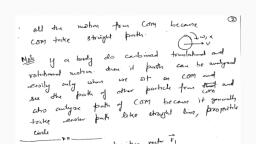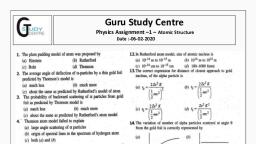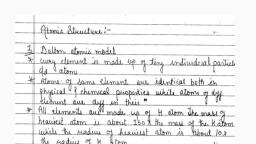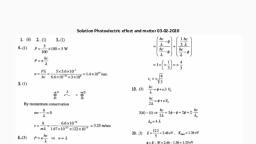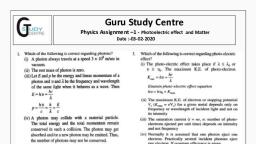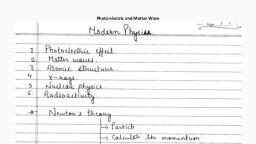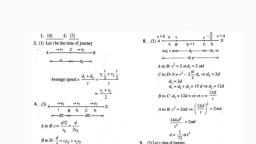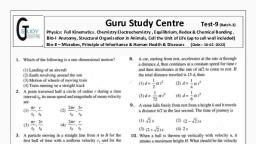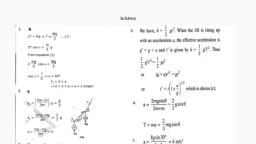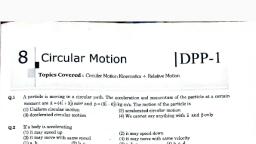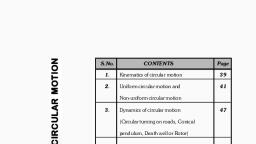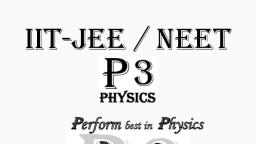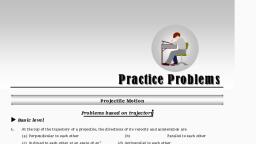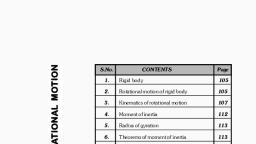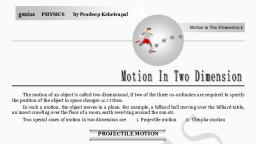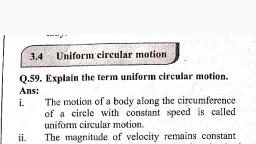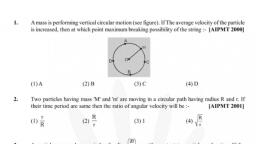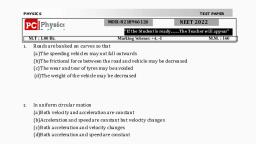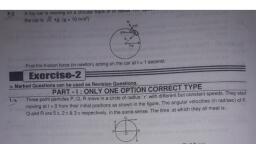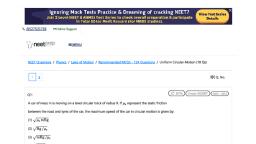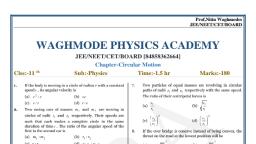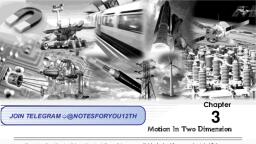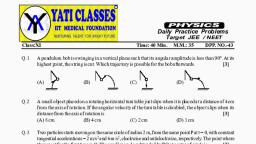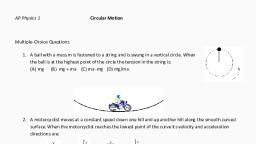Page 1 :
SyJuUDY, CENTRE, , , , , , Guru Study Centre, , Physics Assignment —1 - Circular Motion, (Topic —Angular variable, Dynamic, Banking), , , , , , , , A body revolving ina circle with uniform speed possesses:, (a) normal acceleration (b) uniform acceleration, , (c) tangential acceleration _ (d) none of these, , A stone of taas m is tied to a string of length / and rotated, ina circle wij,a constant speed v, if the string is released,, the stone flies:, , (a) radially outward, , (b) radially inward, 2, (c) tangentially outward ~, , (d) with an acceleration ay a, , If a particle moves in a circle, describing equal angles in, , equal times, its velocity vector:, , (a) remains constant, , (b) changes in magnitude, , (c) changes in direction, , (d) changes both in magnitude and direction, , When a mass is rotating in a plane about a fixed point, its, , angular momentum is directed along:, , (a) the radius, , (b) the tangent to the orbit, , (c) a line perpendicular to the plane of rotation, , (d) none of the above, , The linear velocity of a particle on the equator is nearly:, , (radius of the earth is 4000 miles), , (a) zero (b) 10 mile/hr, , (c) 100 mile/hr (d) 1000 mile/hr, , Certain neutron stars (extremely dense stars) are believed to, , be rotating at about | rev/s. If such a star has a radius of, , 20km, the acceleration of an object on the equator of the star, , will be:, , (a) 20x 10° m/s? (b) 120% 10° m/s?, , (©) 8x 10% m/s? (4) 4x 108 mis?, , A motorcar is travelling at 60 m/s on a circular road of radius, , 1200 m. It is increasing its speed at the rate of 4 m/s”. The, , acceleration of the car is:, , (a) 3 m/s* (b) 4 m/s?, , (c) Sm/s* (4) 7 m/s?, , Which of the following statements about the rotatory, , motion along a circular path is true?, , {a) Linear velocity is uniform when angular velocity is, uniform,, , (b) Magnitude of acceleration is constant., , (c) Acceleration is directed along the tangent to the circular, path., , (d) None of the above statements is correct., , A particle covers equal distance around a circular path, in, , equal intervals of time. Which of the following quantities, , connected with the motion of the particle remains constant, , with time?, , (a) Displacement, , (c) Speed, , (b) Velocity, (d) Acceleration, , GURU STUDY CENTRE (KACHERI ADDA, DHARAMSHALA DISTT. KANGRA), 8988076292, 9882983453 EMAIL:- GURUSTUDY82@GMAIL.COM, WWW.GURUSTUDYCENTRE.COM, , 10., , 11., , 12., , 13., , 14., , 15., , 16., , 17., , 18., , A particle covers equal distances around a circular path in, equal intervals of time. It has uniform non-zero rate of, change of:, , (a) linear displacement (b) angular displacement, , (c) linear velocity (d) angular velocity, , A particle is moving along a circular path. The angular, velocity, linear velocity, angular acceleration and, centripetal acceleration of the particle at any instant, , respectively are @, 0, a, and a~. Which of the following, relations is not correct?, , @s.i? WSLe WGLA MILA, A particle is moving along a circular path of radius 2 m with, , uniform speed of § m s~!. What will be the change in, velocity when the particle completes half of the revolution?, , (a) Zero (b) 10ms"!, () 10V3ms7! (d) 3” s!, , A particle is moving along a circular path of radius 5 m with, a uniform speed Sms ~! What will be the average, acceleration when the particle completes half revolution?, (a) Zero (b) 10ms*, , (©) 10nms~ @ Sms?, , A particle is moving along a circular path with uniform, speed. Through what angle does its angular velocity change, when it completes half of the circular path?, , (a) 0° (b) 45° (c) 180° (d) 360°, , A wheel is subjected to uniform angular acceleration about, its axis. Initially its angular velocity is zero. In the first 2, sec, it rotates through an angle 0); in the next 2 sec it rotates, , through an additional angle 6. The ratio of a is:, 1, , (a) 1 (b) 2 (c)3 (d) 5, , A particle is moving in a circle with uniform speed. It has, constant:, , (a) velocity (b) acceleration, , (c) kinetic energy (d) displacement, , Acar is moving along a circular path of radius 500 m witha, speed of 30 m/s. If at some instant, its speed increases at the, rate of 2 m/s”, then at that instant the magnitude of resultant, acceleration will be:, , (a) 4.7 m/s?, (c)3 m/s?, , (b) 3.8 m/s?, (d) 2.7 mis?, , A motor car is travelling at 30 m /sec on a circular road of, radius 500 m. It is increasing its speed at the rate of 2.0, , ms~?.The total acceleration is:, , (a) 1.8 ms? (b) 2 ms, (c) 3.8 ms (4) 2.7 ms, , CONTACT US :- 8629073248,
Page 2 :
19, Anelectric fan has blades of length 30 cm as measured from 27. Awheel starts rotating at 10 rad/sec and, , the axis of rotation. If the fan is rotating at 1200 rpm, the attains the angular velocity of 100 rad/sec in, acceleration of a point on the tip of the blade is about: 15 seconds: What is the angular acceleration, 2 2 in rad/sec??, (a) — (b) ae (A) 10 (B) 110/15 (C) 100/15 (D) 6, (c) 2370 ms (d) 5055 ms 28. The ratio of angular speed of hours hand and, 20. A wheel is at rest. Its angular velocity increases seconds hand of a clock isuniformly and becomes 80 radian per second afte! oe 4 : a (B) 1:60, 5 second. The total angular displacement is : 3 - : = (D) 3600: 1, . The angular velocity of earth about its axis of, (A) 800 rad (B) 400 rad rotation is- ., (C) 200 rad (D) 100 rad (A) 2n/ (60 x 60 x 24) rad / sec, 21. The second’s hand of a watch has length 6 cm. fel Be j ing ae, / sec, Speed of end point and Magnitude of difference of (D) 2x / (365 x 24 x 60 x 60 ) rad /sec, velocities at two perpendicular positions will be : 30. In circular motion, the centripetal acceleration, (A) 2x &0 mm/s (B) 2V2 2 &4.44 mm/s is given by: (A) a xr (B)wxv, (C) 2V2x &2nmm/s (D) 2x & 2/2 xmm/s (Chaxv (D)oxr, 22. If angular velocity of a disc depends an angle 31. A particle moves in a circle of radius 25 cm at, rotated 0 as @ = 0? + 20, then its angular two revolutions per second. The acceleration of, acceleration a at 0) = 1 rad is particle in m/s? is d/sec? B) 10 rad/sec? (A) x? (8) 8°, (A) 8 rad/se (B) 10 rad/sec’ (C) 4x2 (D) 2x2, (C) 12 rad/sec* (D) None 32. Two bodies of masses 10 kg and 5 kg moving on, 23. A wheel is subjected to uniform angular concentric orbits of radii R and r such that their, , period of revolution are same. The ratio of their, , acceleration about its axis. Initially its angular Senkripetal ecceleration a, , velocitv is zero. In the first 2 sec, it rotates R t R? (2, through an angle 0, ; in the next 2 sec, it rotates (A) ie ®eR © = (D) Poy, through an additional angle 0,. The ratio of oo ., 05/6, is- 33, A small block slides down from the top of a hemisphere of, (A)1 (B)2 radius 7. It is assumed that there is no friction between the, block and the hemisphere. At what height, A will the block, , (C)3 (Db) 5 lose contact with the surface of sphere?, , 24.The linear and angular acceleration of a @e (2 wf @2, particle are 10 m/sec? and 5 rad/sec? 3 3 +2 4, respectively it will be at a distance from the —_34._A body of mass mis moving in a circle of radius r with a, axis of rotation - constant speed v. The work done by the centripetal force in, (A) 50 m, (B) 1/2 m moving the body over half the circumference of the circle, (Cc) 1m (D) 2m is:, , (a) mr (b) zero. (c) mu/r— (A) hmv, , » A grindi 1} i loci f at ocd ., 25. grinding wheel attained a velocity of 20 A patticle of nasa mis bing 2. path of radius r, , rad/sec in 5 sec starting from rest. Find the 35., , number of revolutions made by the wheel. with uniform speed. If L is the angular momentum of the, " particle about the axis of the circle, the kinetic energy of the, (A) 3g revolution per sec particle is given by:, , (a) ime? (6) 2/2mr?(c) 2024 mr? (a) mr? L, , 4, (8) x fevolution! per: sec 36. Two particles of equal masses are revolving in circular, , 25 paths of radii r) and rp respectively with the same period., (C) = revolution The ratio of their centripetal force is:, (D) None @nin JAM ©(nin? @ (rin?, 26. A wheel having a diameter of 3 m starts from 37. A motor car of mass mtravels with a uniform speed v on a, rest and accelerates uniformly to an angular convex bridge of radius r.When the car is at the middle, welocity of 210 r.p.m. in 5 seconds. Angular point of the bridge, then the force exerted by the car on the, acceleration of the wheel is - bridge is:, d 2, (A) 1.42 = (B) 3.3% * (a) mg (b) mg +, 4. tad rad 2 mv?, (C) 2.2" (D) 1.19 a (©) mg -—— (4) mgt, , , , GURU STUDY CENTRE (KACHERI ADDA, DHARAMSHALA DISTT. KANGRA) CONTACT US :- 8629073248,, 8988076292, 9882983453 EMAIL:- GURUSTUDY82@GMAIL.COM, WWW.GURUSTUDYCENTRE.COM
Page 3 :
38, , 39, , 41., , 42., , 43., , 45., , . A stone of mass | kg is tied to the end of string 1 m long. It, , is whirled in a vertical circle. If the velocity of the stone at, the top be4 ms~!, what is the tension in the string?, , (g=10ms~), (a) 16N (b) 10N (c) 6N (d) SN, . A particle moving along the circular path with a speed v and, , its speed increases by g in one second. If the radius of the, circular path be r, then the net acceleration of the particle is:, , v v 2, @—+8 (b) ats, , 2 1/2, v4 2 v, © [Ss @)— +8, . The overbridge of a canal is in the form of a circular are of, , radius R. What is the greatest speed at which a motorcyclist, can cross the bridge without leaving the ground?, , (a) {5gR (bo) J3gR =) BR (A) QR, , A ball of mass 0.25 kg attached to the end of a string of, length 1.96 m is moving in a horizontal circle, The string, will break if the tension is more than 25 N, What is the, maximum speed with which the ball can be moved?, , (a) 14 m/s (b) 3 m/s, , (c) 3.92 m/s (@) 5 m/s, , Asstone of mass | kg, tied to the end ofa string of length 1m,, is whirled in a horizontal circle with a uniform angular, velocity of 2 rad/s, The tension in the string is (in N):, , (a) 2 (b) 1/2 (c) 4 (d) 4, , Acar moving on a horizontal road may be thrown out of the, , road in taking a turn:, , (a) by the gravitational force, , (b) due to the lack of proper centripetal force, , (c) due to the rolling frictional force between the tyre and, road, , (d) due to the reaction of the ground, , A car sometimes overturns while taking a tum. When it, , overturns, it is:, , (a) the inner wheel which leaves the ground first, , (b) the outer wheel which leaves the ground first, , (c) both the wheels leave the ground simultaneously, , (d) either wheel which leaves the ground first, , A motorcyclist moving with a velocity of 72 km per hour on, , a flat road takes a turn on the road at a point, where the, , radius of curvature of the road is 20 metre. The acceleration, , due to gravity is 10 m/sec”. In order to avoid skidding, he, , must not bend with respect to the vertical by an angle, , greater than: x, , (a) @=tan~' 6 (b) @=tan7!2, , (©) @=tan~'(2592) (@) 6=tan7! 4, , A vehicle is moving with a velocity v on a curved road of, , width 6 and radius of curvature R. For counteracting the, , centrifugal force on the vehicle, the difference in elevation, , required in between the outer and inner edges of the road is:, , (a) v2W/Re (b) vbIRg—(c) vb2/Rg(d) wh/R?g, , GURU STUDY CENTRE (KACHERI ADDA, DHARAMSHALA DISTT. KANGRA), 8988076292, 9882983453 EMAIL:- GURUSTUDY82@GMAIL.COM, WWW.GURUSTUDYCENTRE.COM, , 47., , 49., , A cyclist moves on a circular track of radius 100 metre. If, the coefficient of friction is 0.2, then the maximum speed, with which the cyclist can take a turn without leaning, inwards is:, , (a) 9.8ms~! (b) 1.4ms~! (¢) 140 ms“! (d) 14.0 ms!, , . [fa cyclist doubles his speed while negotiating a curve, how, , does the tendency to overtum vary?, , (a) Remains unchanged (b) Doubled, , (c) Halved (d) Quadrupled, , The outer rail of the curved railway track is raised above the, inner one:, , (a) to provide centripetal force, , (b) to overcome the frictional force, , (c) to balance the gravity, , , (d) for some reason other than those mentioned above, , 50., , 51., , 52., , A cyclist bends while taking turn to:, , (a) reduce friction, , (b) generate required centripetal force, , (c) reduce apparent weight, , (d) reduce speed, , A cyclist is riding with a speed of 27 km h7!. As he, approaches a circular turn on the road of radius 80 m, he, applies brakes and reduces his speed at a constant rate of 0.5, ms~!. The magnitude of the net acceleration of the cyclist is:, (a) 0.86 ms~ (b) 0.43 ms, , (0) 1.24 ms (4) 1.76 ms, , A car is negotiating a curve of radius 150 m with a speed of, 15 ms™! . The angle through which the pendulum, suspended from the top of the ceiling would deviate is:, (g=10ms™), (@) tan“! (3120), (c) tan=!(4/15), , (b) tan“!(5/16), (@) tan“!(3/16), , CONTACT US :- 8629073248,
Page 4 :
SyJuUDY, CENTRE, , Guru Study Centre, , Physics Assignment —2 - Circular Motion, , , , , , (Topic Vertical Circle), , , , , , , , 1, , », , ~, , 2, , A bucket full of water is revolved in vertical circle of 2 m., What should be the maximum time-period of revolution so, that water does not fall off the bucket?, , (a) 1 sec (b) 2 sec (c) 3 sec (d) 4 sec, Astone of mass | kg is tied to the end of | m long string and, is whirled in a vertical circle. The velocity of stone at the, bottom of the circle is just sufficient to take it to the top of, the circle without slackening the string. What is the tension, in the string at the top of the circle? (Take g=10 ms~*), (a) Zero @)IN (c) VION (d) 10N, , . Inthe Q. 2. *, what will be the tension in the string when it, , becomes horizontal?, , (a) Zero (b) IN {c) 1ON (d) 30N, , A bucket tied at the end ofa 1.6 m long string is whirled ina, vertical circle with constant speed. What should be the, minimum speed so that the water from the bucket does not, spill when the bucket is at the highest position?, (Take g =10 ms), , 10., , Astone of mass | kg is tied to the end of string | m long. It, is whirled in a vertical circle. If the velocity of the stone at, the top be 4 ms™!, what is the tension in the string?, , (g=10ms~), (a) 16N (b) 10N, , (c) 6N (d) 5N, , . Assimple pendulum consists of a light string from which a, , spherical bob of mass M is suspended. The distance, between the point of suspension and centre of the bob is /., ‘The bob is given a tangential velocity v at the equilibrium, position ( i.¢.,at the lowest point), What can be maximum, value of velocity v, so that the pendulum oscillates without, the string becoming slack?, , (©) J4gl — @) Sei, , (a) gi (b) Y2gi, , . Inthe Q. 11. , fv =./2gi , the angle described by the string, , going from one extreme position to the other will be:, 5 x 3n, (a) a (b) 3 (©) 2 (d) x, , . Inthe Q. 11.’ the string will become slack and the bob will, , (a) 4ms! (b) 6.25ms! leave the circular path, when v is equal to:, , (c) 16ms"! (d) None of these (a) agi (b) al (©) f2gi = @) gi, , A 1 kg stone at the end of 1 m long string is whirled ina 14, In the Q. 11. ifo= /5gi, what will be the velocity of the, vertical circle at constant speed of 4 m/sec. The tension in bob at the top of the vertical circle?, , the string is 6 N when the stone is at: (Take g =10 m/sec”) (a) el (b) ei () viel (d) ag, , (a) top of the circle (b) bottom of the circle, (c) halfway down (d) none of these, , . The string of a pendulum of length / is displaced through, 90° from the vertical and released, Then, the minimum, strength of the string in order to withstand the tension as the, pendulum passes through the mean position is:, (a) mg (b) 3mg (c) S mg, A pendulum consisting of a small sphere of mass M, suspended by an inextensible and massless string of length /, is made to swing in a vertical plane. If the breaking strength, of the string is 2Mg, then the maximum angular amplitude, of the displacement from the vertical can be:, (a) © (b) 30° (c) 60°, A stone is tied at the end of a string 4 m long and whirled in, acircle in a vertical plane; the minimum speed of the stone, at the lowest point for the circular motion to be just, completed is:, (a) 7 m/s (b) 14m/s_ (c) 28m/s_— (d) 6.3 m/s, A simple pendulum of length L and mass (bob) M is, oscillating in a plane about a vertical line between angular, limits — and +4. For an angular displacement 6, where, |@\<{®| the tension 7 in the string and the velocity V of the, bob are related as under in the above conditions:, , 2, (a) Toos @=Mg (b) T-Mgcose =>, , (c) T=Mgcos@ (d) none of these, , GURU STUDY CENTRE (KACHERI ADDA, DHARAMSHALA DISTT. KANGRA), 8988076292, 9882983453 EMAIL:- GURUSTUDY82@GMAIL.COM, WWW.GURUSTUDYCENTRE.COM, , Inthe Q. 11, , ifv = \/5gi, the kinetic energy of the bob at the, top of the circle will be:, (a) zero, , (c) 2Mgl, , (b) Mgi, (d) none of these, , (8) Cine 16. In the Q. al if v= 5gi, » Kinetic energy of the bob,, when the string becomes horizontal, will be:, (@) zero oe!, (c) se (d) none of these, , (d) 90° 17,. A body of mass | kg is rotating in a vertical circle of radius, , I m. What will be the difference in its kinetic energy at the, top and bottom of the circle? (g =10ms~ ), (a) 10) (b) 205, , (c) 305 (d) 50), , A weightless thread can support tension upto 30 N, A stone, of mass 0.5 kg is tied to it and is revolved in a circular path, of radius 2m in a vertical plane. If g=10ms~*, then the, maximum angular velocity of the stone will be:, , (a) 5 rad/s (b) 30 rad/s |, L (©) V6 rad/s (d) 10 rad/s, , CONTACT US :- 8629073248,
Page 5 :
19., , a., , A frictionless track ABCDE ends, in a circular loop of radius R. A, body slides down the track from, point A which is ata heighth=$5 _, cm. Maximum value of R for the, body to successfully complete the, loop is:, , (som — (b) Bem =) em =) 20m, , 4 3, , A vehicle of mass 1500 kg is moving along a curved path of, length 314 m with a speed of 20 ms”! . If it takes a tum of, 90°, the centripetal force needed by the vehicle is:, , (a) 1000N —(b) 2000N = (c) 3000N 9 (d) 4000N, , A.ccaris moving with a speed of 10 ms~! onaconcave road, of radius 100 m. If the mass of the car is 700 kg, then the, reaction on the car tyres when it is at the lowest position will, be:, , (a) 4560N (b) 5560N (c) 6560N (d) 7560N, A stone of mass | kg tied to a light inextensible string of, length Z=10/3 metre is whirling in a circular path of radius, L, ina vertical plane. If the ratio of the maximum tension in, the string to the minimum tension is 4 and ifg is taken to be, 10 metre persec”, the speed of the stone at the highest point, of the circle is:, , (a) 20 metre per sec (b) 10/3 metre per sec, , (c) 5V2metre per sec (4) 10 metre per sec, , A stone tied to a string of length L is whirled in a vertical, circle with the other end of the string at the centre, At a, certain instant of time, the stone is at its lowest position and, has a speed u. The magnitude of the change in its velocity as, itreaches a position where the string is horizontal is;, , (2) yu? -2¢L (b) 2gL, , (© \u? =e (@) yu? -gL), , , , GURU STUDY CENTRE (KACHERI ADDA, DHARAMSHALA DISTT. KANGRA) CONTACT US :- 8629073248,, 8988076292, 9882983453 EMAIL:- GURUSTUDY82@GMAIL.COM, WWW.GURUSTUDYCENTRE.COM



